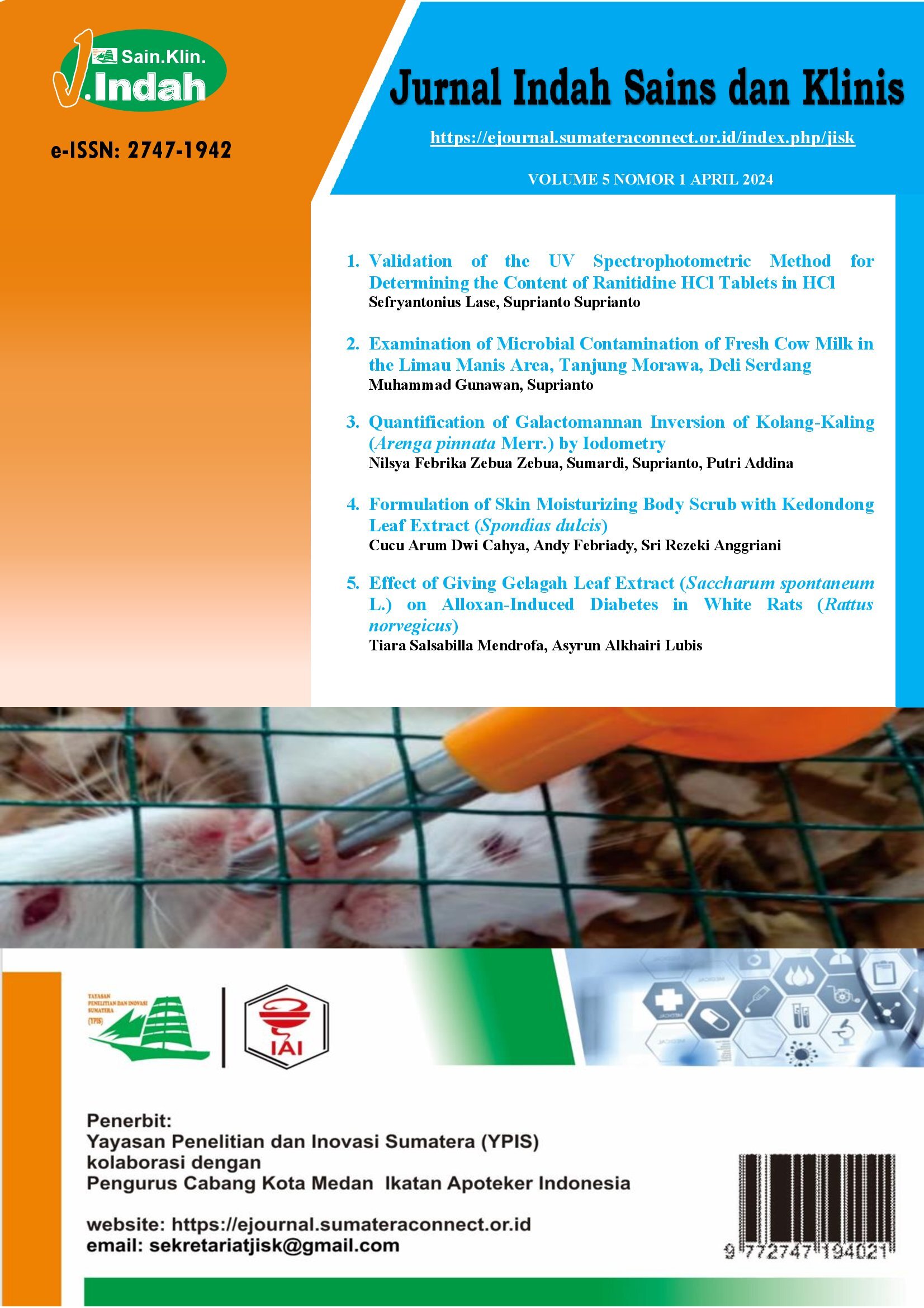Examination of Microbial Contamination of Fresh Cow Milk in the Limau Manis Area, Tanjung Morawa, Deli Serdang
DOI:
https://doi.org/10.52622/jisk.v5i1.02Keywords:
Fresh milk, contaminants, microbesAbstract
Background: Milk serves as a crucial source of human nutrition, particularly for infants who rely on it before they can digest solid foods. The mammary glands of female mammals produce it and is typically characterized by its pure white appearance. Objective: This study aimed to assess the levels of mesophilic aerobic bacteria and yeast mould present in fresh cow's milk obtained from farms in Limau Manis Tanjung Morawa. Methods: The investigation into contamination levels employed the Total Plate Count (TPC) method for aerobic bacteria and the Yeast Mold Count (YMC) method, both of which are based on the guidelines outlined in the Indonesian National Standard (SNI) No. 3141.1 of 2011. Results: Findings revealed that the levels of aerobic mesophilic bacteria, as determined by the TPC method, met the stipulated requirements of SNI No. 3141.1 of 2011 across all five farms surveyed. However, the research utilizing the YMC method indicated that the yeast mould counts in the milk from all five farms did not meet the established criteria. Conclusion: The analysis of microbial contamination using the TPC and YMC methods demonstrated compliance and non-compliance, respectively, with the standards outlined in SNI No. 3141.1 of 2011.
Downloads
References
Z. Hanum, Yurliasni, and Dzarnisa, Teknologi Pengolahan Susu. Banda Aceh: Syiah Kuala University Press, 2022.
Badan Standarisasi Nasional, SNI 3141.12011 tentang Susu Segar Bagian 1: Sapi, vol. 3141. 2011: Badan Standarisasi Nasional.
R. M. Rumanti, S. Suprianto, J. Tarigan, and A. M. S. Ramadani, “Potensi Antibakteri Kombinan Zingiber officinale Roscoe. Var. Rubrum dengan Cinnamomum burmannii terhadap Staphylococcus aureus,” J. Indah Sains dan Klin., vol. 2, no. 1, pp. 6–10, 2021, doi: 10.52622/jisk.v2i1.8.
D. Syukriani, I. Irda, and D. Kurnia, Ilmu Ternak Perah. Tanjung Pati: Politeknik Pertanian Negeri Payakumbuh, 2022.
S. Suprianto, S. Sumardi, S. Samran, D. Meilani, and D. Kartika, “Passion-Oranges Syrup Production Gung Pinto Village Tanah Karo,” J. Pengmas Kestra, vol. 3, no. 1, pp. 6–12, 2023, doi: 10.35451/jpk.v3i1.1697.
M. R. Ramadhan, “Total Plate Count Susu Murni pada Proses Penanganan Susu Sapi Perah Konvensional dan Modern,” Skripsi, 2017.
A. Y. Pradika, S. Chusniati, M. T. E. Purnama, M. H. Effendi, A. Yudhana, and P. A. Wibawati, “Uji Total Escherichia coli pada Susu Sapi Segar di Koperasi Peternak Sapi Perah (KPSP) Karyo Ngremboko Kecamatan Purwoharjo Kabupaten Banyuwangi,” J. Med. Vet., vol. 2, no. 1, pp. 1–6, 2019.
F. Navyanti and R. Adriyani, “Higiene Sanitasi, Kualitas Fisik dan Bakteriologi Susu Sapi Segar Perusahaan Susu X di Surabaya,” J. Kesehat. Lingkung., vol. 8, no. 1, pp. 36–47, 2015.
R. J. Yudonegoro, N. Nurwantoro, and D. W. Harjanti, “Kajian Kualitas Susu Segar Dari Tingkat Peternak Sapi Perah, Tempat Pengumpulan Susu dan Koperasi Unit Desa Jatinom Di Kabupaten Klaten,” Anim. Agric. J., vol. 3, no. 2, pp. 323–333, 2016.
E. R. V. Nanda, N. Harijani, and P. A. Wibawati, “Uji Total Bakteri Susu Segar Kambing Jawa Randu di Siliragung, Banyuwangi,” J. Med. Vet., vol. 3, no. 2, pp. 224–229, 2020.
N. S. Anindita and D. S. Soyi, “Studi Kasus: Pengawasan Kualitas Pangan Hewani melalui Pengujian Kualitas Susu Sapi yang Beredar di Kota Yogyakarta,” J. Peternak. Indones., vol. 19, no. 2, pp. 96–105, 2017.
N. I. H. Siagian, T. Ashar, and D. N. Santi, “Analisis Jamur Penicillium dan Jamur Khamir Pada Minuman Susu Kemasan Dan Susu Segar yang Beredar Di Kota Medan Tahun 2015,” Concept Communication, null, pp. 301–316, 2019.
H. Resnawati, “Kualitas Susu pada Berbagai Pengolahan dan Penyimpanan,” Semiloka Nas. Prospek Ind. Sapi Perah Menuju Perdagang. Bebas, vol. 497, p. 502, 2020.
D. Cahyono, M. C. Padiaga, and M. E. Sawitri, “Microbiological Qualities (TPC, Enterobacteriaceae, Staphylococcus aureus) of Fresh Milk from Subdistrict Krucil Probolinggo,” J. Ilmu dan Teknol. Has. Ternak, vol. 8, no. 1, pp. 1–8, 2013.
O. H. A. Latifa, “Identifikasi Bakteri Escherichia coli pada Susu Sapi Segar dan Susu Sapi Cair Kemasan Ultra High Temperature (UHT) di Kecamatan Mampang Prapatan Tahun 2015.” UIN SYarif Hidayatullah Jakarta: Fakultas Kedokteran dan Ilmu Kesehatan, 2015, 2015.
T. Rachmatiah, R. Anggraini, and I. Sigoro, “Analisis Cemaran Mikroba, Kandungan Nutrisi pada Susu Sapi Segar Hasil Peternakan Sapi Perah,” J. Penelit. dan Pengkaj. Sains dan Teknol., vol. 23, no. 2, pp. 91–94, 2013.
Downloads
Published
Issue
Section
License
Copyright (c) 2024 Jurnal Indah Sains dan Klinis

This work is licensed under a Creative Commons Attribution-NonCommercial-ShareAlike 4.0 International License.









 This work is licensed under a
This work is licensed under a 
